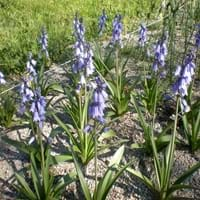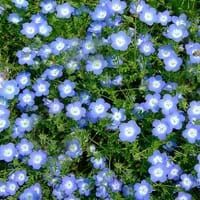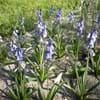Life Span
Perennial
Annual
Type
Bulb or Corm or Tuber
Flowering Plants, Herbs
Origin
Southern Europe, Western Europe, Northern Africa
Western United States, Alaska, California
Types
Hyacinthoides flahaultiana, Hyacinthoides mauritanica, Hyacinthoides reverchonii
Nemophila menziesii var. atomaria, Nemophila menziesii var. integrifolia, Nemophila menziesii var. menziesii
Number of Varieties
Not Available
Habitat
Parks, wastelands, Waysides, Woodland edges
Chaparral, Grassland
USDA Hardiness Zone
4-10
3-9
AHS Heat Zone
9-1
Not Available
Sunset Zone
21,22
A1, A2, A3, H1, H2, 1a, 1b, 2a, 2b, 3a, 3b, 4, 5, 6, 7, 8, 9, 10, 11, 12, 13, 14, 15, 16, 17, 18, 19, 20, 21, 22, 23, 24
Habit
Clump-Forming
Cushion/Mound-forming
Flower Color
White, Blue, Pink, Blue Violet
White, Blue, Light Blue, Sky Blue
Flower Color Modifier
Bicolor
Bicolor
Fruit Color
Not Available
Not Available
Leaf Color in Spring
Green
Green
Leaf Color in Summer
Light Green
Green
Leaf Color in Fall
Several shades of Green
Not Available
Leaf Color in Winter
Light Green
Light Green
Plant Season
Spring
Spring, Summer, Winter
Sunlight
Partial Sun, Partial shade
Full Sun, Partial Sun
Growth Rate
Medium
Very Fast
Type of Soil
Loam
Loam, Sand
The pH of Soil
Acidic, Neutral
Acidic, Neutral
Soil Drainage
Well drained
Well drained
Bloom Time
Spring, Late Spring
Early Spring, Spring, Late Spring, Winter, Late Winter
Tolerances
Drought
Drought
Where to Plant?
Ground
Ground
How to Plant?
By dividing rhizomes, tubers, From bulbs, Seedlings
Seedlings
Plant Maintenance
Medium
Medium
Watering Requirements
Average Water Needs, Do Not over Water, Requires regular watering
Do not water frequently, Never Over-water
In Summer
Lots of watering
Lots of watering
In Spring
Moderate
Moderate
In Winter
Average Water
Average Water
Soil pH
Acidic, Neutral
Acidic, Neutral
Soil Type
Loam
Loam, Sand
Soil Drainage Capacity
Well drained
Well drained
Sun Exposure
Partial Sun, Partial shade
Full Sun, Partial Sun
Pruning
Pinch Tips, Remove damaged leaves, Remove dead branches, Remove dead leaves, Remove dead or diseased plant parts
Not Available
Fertilizers
High amounts of nutrients, organic fertlizers
All-Purpose Liquid Fertilizer
Pests and Diseases
Red blotch
Red blotch
Plant Tolerance
Drought
Drought
Flower Petal Number
Single
Single
Foliage Texture
Medium
Fine
Foliage Sheen
Glossy
Not Available
Invasive
Sometimes
Sometimes
Attracts
Birds, Butterflies, pollinators
Bees, Butterflies
Allergy
Pollen
Not Available
Aesthetic Uses
Showy Purposes
Beautification, Bouquets, Showy Purposes
Beauty Benefits
Not Available
Not Available
Environmental Uses
Air purification
Air purification
Medicinal Uses
Not Available
Pain killer
Part of Plant Used
Flowers
Flowers
Other Uses
Beneficial species for attracting pollinators, Decoration Purposes, Showy Purposes, Used for Landscaping
Not Available
Used As Indoor Plant
No
No
Used As Outdoor Plant
Yes
Yes
Garden Design
Container, Cutflower, Mixed Border, Rock Garden / Wall, Wildflower
Bedding Plant, Container, Hanging Basket, Mixed Border, Wildflower
Botanical Name
HYACINTHOIDES hispanica
NEMOPHILA menziesii
Common Name
Spanish Bluebell
Baby Blue Eyes
In Hindi
Bluebell plant
Baby Blue Eyes Plant
In German
Endymion Pflanze
Baby Blue Eyes Pflanzen
In French
plante Bluebell
bébé yeux bleus usine
In Spanish
planta Bluebell
bebé ojos azules planta
In Greek
φυτό Bluebell
μωρό μπλε μάτια των φυτών
In Portuguese
planta Bluebell
bebê olhos azuis planta
In Polish
Bluebell roślin
dziecko niebieskie oczy roślin
In Latin
Bluebell herba
baby blue eyes plant
Phylum
Magnoliophyta
Not Available
Class
Liliopsida
Magnoliopsida
Order
Liliales
Not Available
Family
Liliaceae
Boraginaceae
Genus
Hyacinthoides
Nemophila
Clade
Angiosperms, Monocots
Angiosperms, Asterids, Eudicots
Tribe
Hyacintheae
Not Available
Subfamily
Scilloideae
Hydrophylloideae
Season and Care of Bluebell and Baby Blue Eyes Plant
Season and care of Bluebell and Baby Blue Eyes Plant is important to know. While considering everything about Bluebell and Baby Blue Eyes Plant Care, growing season is an essential factor. Bluebell season is Spring and Baby Blue Eyes Plant season is Spring. The type of soil for Bluebell is Loam and for Baby Blue Eyes Plant is Loam, Sand while the PH of soil for Bluebell is Acidic, Neutral and for Baby Blue Eyes Plant is Acidic, Neutral.
Bluebell and Baby Blue Eyes Plant Physical Information
Bluebell and Baby Blue Eyes Plant physical information is very important for comparison. Bluebell height is 30.00 cm and width 15.00 cm whereas Baby Blue Eyes Plant height is 10.20 cm and width 20.30 cm. The color specification of Bluebell and Baby Blue Eyes Plant are as follows:
Bluebell flower color: White, Blue, Pink and Blue Violet
Bluebell leaf color: Green
Baby Blue Eyes Plant flower color: White, Blue, Light Blue and Sky Blue
- Baby Blue Eyes Plant leaf color: Green
Care of Bluebell and Baby Blue Eyes Plant
Care of Bluebell and Baby Blue Eyes Plant include pruning, fertilizers, watering etc. Bluebell pruning is done Pinch Tips, Remove damaged leaves, Remove dead branches, Remove dead leaves and Remove dead or diseased plant parts and Baby Blue Eyes Plant pruning is done Not Available. In summer Bluebell needs Lots of watering and in winter, it needs Average Water. Whereas, in summer Baby Blue Eyes Plant needs Lots of watering and in winter, it needs Average Water.





